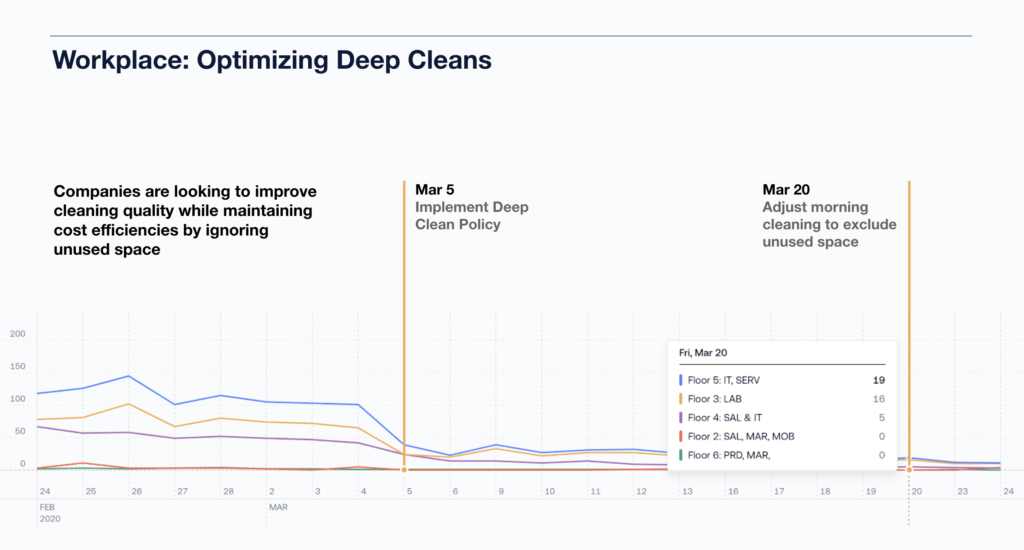The push to return to the office varies depending on which company you ask. Across the world, industry leaders are creating customized return-to-work plans based on their employee needs. Bank of America has adopted an office-only policy, while Microsoft and Google have taken to a hybrid approach.
Data gathered by CREtech expected nearly 60% of all employees to be back in the office by the end of Q1 2021. One year later, those results fell short as the pandemic continued to pick up steam, and employees demanded more flexibility in their workplace locale.
Workplace leaders are approaching the future of work with the understanding of prioritizing what employees need and what will drive them to come back to the office. Sure, offices may look differently. A shift to flexible and remote work will keep some people home — which aligns with a need for social distancing at the workplace. Still, millions upon millions of people will find themselves back in an office, at least a few days a week, in the not-so-distant future.
How do company leaders bring these employees back safely?
We interviewed a number of our clients, ranging from tech companies to financial services organizations, to find out what they’re doing to craft their post-coronavirus return to work policy.
For context, our customers collectively manage over a billion square feet of space (35 sq. miles). Bringing their workers back safely and efficiently is (it’s almost needless to say) top of mind.
TL;DR: Companies are relying on occupancy sensors to maintain lower capacity levels, track employee compliance, and remain COVID-compliant.
Promote social distancing with occupancy limits
It will take time to bring employees back into the office, full time. By imposing limits on the total number of employees allowed in the office, or on individual floors, our clients are protecting employees from potential contagious social interactions.
Using real-time occupancy data, they ensure that only so many people are populating specific sections of a floor, building, or campus. Over time, facilities teams will re-introduce more employees to the space and still keep tabs on where people are and how many people are there. This leads to a “phased approach” to returning, which avoids overcrowding and mitigates concerns about potential transmission. (More on phased approach below).
Take a phased approach to reopening your office
Having pre-COVID occupancy levels on day one is not realistic — or safe. We are no longer in a world where work expectations are driven from one location with a set schedule. For many, their home office has been their safe haven of comfort, deep work, and a flexible extension of their personal and professional lives. Your workplace leadership teams have an opportunity to safeguard employee health and experience, and to instill confidence that it’s indeed safe to return to work.
Our clients see a phased approach as an effective strategy. It also reduces the burden already levied upon facilities crews who are working overtime to keep up with deep cleaning schedules. Additionally, a phased approach reduces the risk of the worst case scenario in which a contagious employee returns to the office and passes the illness to others.
Having pre-COVID occupancy levels on day one of your reopening is not realistic — or safe.
With occupancy data, our clients see exactly how the phases of a reentry program will change in the ensuing months. They can keep track of daily visits, team locations, occupied and/or vacant spaces, and pinpoint what areas of the offices need cleaning and what areas do not. By removing the guesswork, reliable occupancy data saves them time and money, and, importantly, assists in keeping people healthy.
Related reading: Using occupancy data to streamline cleaning services.
Stagger scheduling to maintain lower occupancy limits
Another way our clients use occupancy data to navigate their return to the office is by staggering employee schedules. Employers are considering assigning team shifts and alternate work hours. Much like the phased approach, schedule staggering limits the number of people allowed in a space at any given time. If companies can identify how many people are in different areas of a building/floor, they can create time-based allotments for office visits. This would reduce the risk of transmission between employees simply because they would occupy the same space at different times.
This can also benefit employees who take public transportation to work. If someone who usually arrives at 9:00 in the morning can actually take a noon train, they’ll avoid rush hour busyness during their commute, thus reducing the number of people in transit, as well as the potential for contagious interaction. If companies apply a staggered schedule strategy, they will also be able to direct essential staff and cleaning crews to targeted areas based on who has been where according to the agenda.
Related reading: Entryway bottlenecks and risks to social distancing.
Create a cost-effective cleaning strategy
As a general rule, office space is cleaned on a schedule—and in many cases, the same number of staff hours are spent on a highly trafficked lobby as on conference rooms that have been used for a single meeting.
But the pandemic has changed the rules. Cleaning is more important now than ever before. And it’s incredibly costly.
Clients use Density’s sensor data to laser-focus their cleaning efforts according to how many people have used the space.

Density data has been especially helpful in places where people congregate in larger groups, such as cafeterias. Some teams with shared cafeterias have implemented “assigned” lunch periods to allow for greater space and the opportunity to clean surfaces between visits.
This approach has given facilities teams enough time to clean and sterilize popular gathering areas before the next wave of people come in to eat.
Occupancy data provides the real-time, actionable insight necessary to implement this type of use-based cleaning. Because our clients know how many people are in a certain place and when, they avoid wasting time cleaning areas that are not used.
Related reading: Office cafeteria safety in the COVID-19 workspace.
Use data to monitor compliance
First, some context:
Early in the COVID-19 crisis, despite wanting to emphasize remote work, most companies in the United States only instituted “recommended” and “use your best judgement” policies. But leaning on Slack and Zoom for communication doesn’t mean your team is hunkered down at their home office.
The data we compiled found that early on in the pandemic, most employees continued to show up to the office.
The overall occupancy of real estate office buildings didn’t decrease as meaningfully as companies hoped — we experienced this within our own offices in San Francisco and New York. Because of this, many companies (including us) evolved our policies. We mandated stay-at-home orders.
Result: The number of employees coming to work fell nearly to zero.

Remote working was no longer an option, it became a rule.
Aside from essential staff, no one has been allowed to come into the office, and our Density data certainly reflects that change. Occupancy numbers fell off a cliff on March 12th. The corporate employee exodus was in full swing — and we had data to prove it.
Our clients also use our sensor data to monitor employee compliance with ever-changing mandates. As a COVID-19 vaccine becomes widely distributed, companies will use Density occupancy data to monitor and enact reentry programs in a safe and strategic way.
